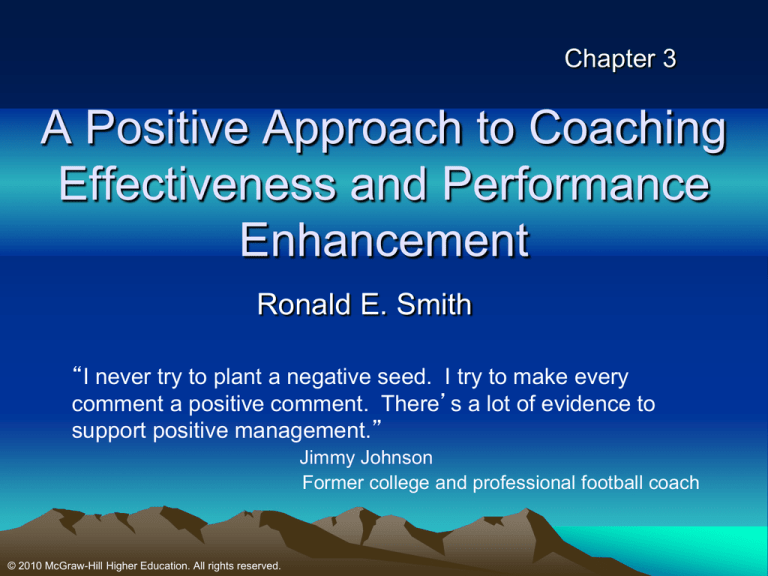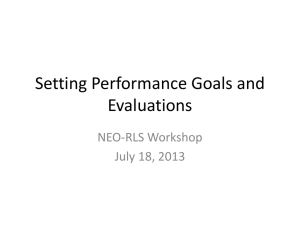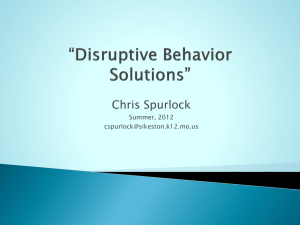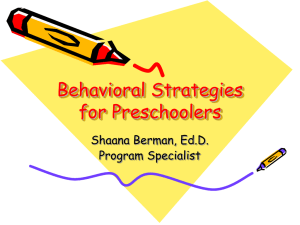
Chapter 3
A Positive Approach to Coaching
Effectiveness and Performance
Enhancement
Ronald E. Smith
“I never try to plant a negative seed. I try to make every
comment a positive comment. There’s a lot of evidence to
support positive management.”
Jimmy Johnson
Former college and professional football coach
© 2010 McGraw-Hill Higher Education. All rights reserved.
What Coaches Say
“To really win, you have to get every player to
go beyond his capabilities. He must feel great
about himself…He must feel that his coaches or
supervisors have total confidence in his ability,
and he must feel that his weaknesses are small
and his strengths are much bigger. You do that
by positive reinforcement, making sure
that no one thinks negatively at any time.”
Rick Pitino
Basketball Coach
University of Louisville
© 2010 McGraw-Hill Higher Education. All rights reserved.
Influence in a Sport Setting
Who influences?
•
•
•
•
Teammates
Opponents
Officials
Coaches
© 2010 McGraw-Hill Higher Education. All rights reserved.
What is influenced?
•
•
•
•
Thoughts
Emotions
Motivational factors
Behaviors
Psychology of Coaching
• Set of strategies
designed to increase a
coaches ability to
influence the behavior of
others more effectively
© 2010 McGraw-Hill Higher Education. All rights reserved.
The ABCs of Behavior Control
• Operant Conditioning:
– The manner in which our behaviors are
influenced by their consequences
• ABC functional assessment:
– Antecedents immediately prior to behavior
(A)
– Behavior occurred (B)
– Consequences immediately following (C)
© 2010 McGraw-Hill Higher Education. All rights reserved.
The ABC’s of Behavior Control
(cont.)
Results in two important relationships:
1. Relationship between antecedents and
behaviors (A and B)
2. Contingency between behavior and its
consequences (B and C)
•
Behavior is strongly influenced by the consequences it
produces
© 2010 McGraw-Hill Higher Education. All rights reserved.
Antecedents
• Discriminative stimuli:
– Signals that guide behavior, certain behaviors
occur only under certain stimuli
• Stimulus control:
– Behavior always occurs under certain stimuli
and may be automatic
© 2010 McGraw-Hill Higher Education. All rights reserved.
Response Consequences
•
•
•
•
•
Positive reinforcement
Negative reinforcement
Extinction
Punishment (aversive)
Punishment (response cost)
© 2010 McGraw-Hill Higher Education. All rights reserved.
Response Consequences
• Positive reinforcement
– Present a stimuli that future
likelihood of the behavior that
preceded it
• Negative reinforcement
– Remove an aversive stimuli - future likelihood of the
behavior that preceded it
© 2010 McGraw-Hill Higher Education. All rights reserved.
Response Consequences (cont.)
• Punishment (aversive)
– Present aversive stimuli that future
likelihood of the behavior that preceded it
• Punishment (response cost)
– Remove a positive stimulus -- future
likelihood of the behavior that preceded it
• Extinction
– Removal of a positive stimulus that has in the
past followed the behavior
© 2010 McGraw-Hill Higher Education. All rights reserved.
Positive vs. Aversive Control
Behavior is strongly influenced by its
consequences
INCREASE BEHAVIOR
POSITIVE
CONTROL
Positive
Reinforcement
Negative
Reinforcement
Extinction
Punishment
DECREASE BEHAVIOR
© 2010 McGraw-Hill Higher Education. All rights reserved.
AVERSIVE
CONTROL
Aversive Control
• Negative side effects of aversive punishment:
– Fear of failure (associated with choking)
– Unpleasant environment (e.g., resentment,
hostility)
– Cohesion built on hatred of coach
– Inappropriate modeling
• Response cost punishment has fewer
detrimental effects and, therefore, better than
aversive
• Criticism and punishment is more effective
when limited
© 2010 McGraw-Hill Higher Education. All rights reserved.
Aversive Control (cont.)
• Reasons why some coaches succeed with
aversive control:
– They also communicate caring for their
players as people, so that aversive feedback
is not “taken personally”
– They have very talented athletes
– They are such skilled teachers and strategists
that these abilities overshadow their negative
approach
© 2010 McGraw-Hill Higher Education. All rights reserved.
The Positive Alternative
• Strengthens desired behaviors through
– positive reinforcement
– instructional feedback given within a supportive
atmosphere
“Catch people doing it right, encourage them,
and then build on that.”
• Mistakes are not seen as totally negative
occurrences
• Fosters more positive learning environment and
relationships among coaches and athletes
© 2010 McGraw-Hill Higher Education. All rights reserved.
Positive Reinforcement
• Effective use of reinforcement:
– Find a reinforcer that works for a particular
athlete
– Make the occurrence of reinforcement
dependent on performance of the desired
behavior
– Make sure the athlete understand why the
reinforcement is being given
• Reinforcement contingencies:
– Relations between behaviors and their
consequences
© 2010 McGraw-Hill Higher Education. All rights reserved.
Positive Reinforcement (cont.)
• Choosing effective reinforcers
– Not all reinforcers are created equal
• Selecting target behaviors & reinforcing
– It must be specific
– Good to strengthen skills the athlete is just
beginning to master, “reward power”
• Shaping
– Reinforce what can do and then reinforce
closer and closer approximations to the final
behavior
© 2010 McGraw-Hill Higher Education. All rights reserved.
Positive Reinforcement (cont.)
• Schedules and timing of reinforcement:
– The pattern and frequency with which
reinforcement is administered
– Give immediately after appropriate behavior
– Continuous is best for new skills
– Partial (intermittent) after mastered
• Reinforce effort and other desirable
behaviors
– Reinforce effort as much as results
– Reinforce teamwork, cohesion, compliance
© 2010 McGraw-Hill Higher Education. All rights reserved.
Reinforcement and Intrinsic
Motivation
• Intrinsic Motivation:
– Motivated to perform an activity for
its own sake, “for the love of the
game”
• Extrinsic Motivation:
– Perform activity only to obtain
some external reward
© 2010 McGraw-Hill Higher Education. All rights reserved.
Reinforcement and Intrinsic
Motivation (cont.)
• Can extrinsic motivation undermine
intrinsic motivation?
– Sometimes, yes. A person may attribute
his/her performance to extrinsic reward
(athletes on scholarship)
– However, extrinsic reinforcement unlikely to
undermine intrinsic motivation if it provides
feedback on meeting a standard of excellence
© 2010 McGraw-Hill Higher Education. All rights reserved.
Positive Reinforcement and Motivational
Climate
• Motivational climate strongly effects
achievement goals
• Children more likely to develop intrinsic
motivation and healthy achievement strategies
in task-involving environments
• Foster a task-oriented climate and goals
when:
– Reinforce effort, persistence, and improvement
• Foster ego-oriented climate and goals when:
– Reinforce outperforming others, punish unsuccessful
performance, fail to attend to effort
© 2010 McGraw-Hill Higher Education. All rights reserved.
Performance Feedback
• Providing the athlete with “knowledge
of results”
– Performance has met or exceeded the
coach’s standards
© 2010 McGraw-Hill Higher Education. All rights reserved.
How Does Feedback Motivate?
• Corrects misconceptions
• Creates internal consequences such as
positive or negative feelings about self
depending on performance
• Increases effort, effect if public (posting
statistics)
• Informs how doing compared to goals,
other norms, past performance
• Results in self-efficacy
© 2010 McGraw-Hill Higher Education. All rights reserved.
Instructional Benefits of Feedback
• Directs behavior -- particularly good when
skills broken down into components or
stages
• Effectively monitors progress
• Tells what correct, wrong, and how to
correct
• When giving feedback after a mistake,
better received if viewed as credible,
specific and high quality, and delivered
supportively
© 2010 McGraw-Hill Higher Education. All rights reserved.
Implementing a Performance Measurement
and Feedback System
• Coach must identify specific and measurable
behaviors or consequences (something that
can be counted)
• May want to measure successful execution
versus just outcome
• Measure correct behaviors rather than
mistakes
• Develop “total performance indexes”
• Provide performance feedback for subgroups
when appropriate
© 2010 McGraw-Hill Higher Education. All rights reserved.
Summary: Providing Positive
Reinforcement
• Do liberally, particularly in early stages
• Have realistic expectations and consistently
reinforce compliance
• Reinforce desired behaviors immediately
• Reinforce effort/perseverance vs. just results
• Pair with statement of what did correctly
• Reinforce compliance with team rules
• Help athletes set positive, individualized,
behavioral performance goals
© 2010 McGraw-Hill Higher Education. All rights reserved.
Summary: Reacting to Mistakes
• Regard mistakes as learning opportunities
• Ask athletes what they should have done
instead
• Give encouragement if athlete knows how to
correct, if not demonstrate
• Deliver using “positive sandwich”
• Restrict to behaviors within athlete’s control,
such as lack of effort
• Avoid aversive punishment as much as
possible
– Response cost is more desirable alternative
© 2010 McGraw-Hill Higher Education. All rights reserved.









